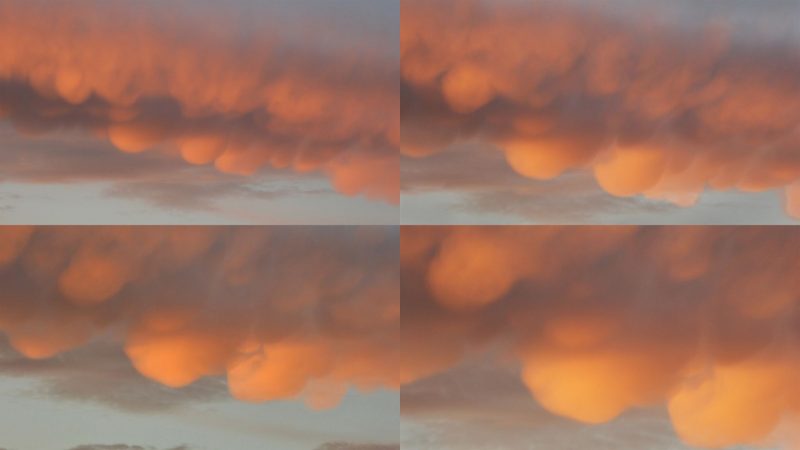

View at EarthSky Community Photos. | Peter Lowenstein captured these spectacular mammatus clouds in Mutare, Zimbabwe, on March 23, 2020. He wrote: “I took an early morning walk up to the Murambi High Level Water Tanks in the hope of catching a glimpse of the very thin old moon rising. Instead there was a surprise appearance of mammatus clouds on the underside of a sunrise-illuminated band of altostratus cloud above.”
Mammatus clouds are pouch-like protrusions hanging from the undersides of clouds, usually thunderstorm anvil clouds but other types of clouds as well. Composed primarily of ice, these cloud pouches can extend hundreds of miles in any direction, remaining visible in your sky for perhaps 10 or 15 minutes at a time.
People associate them with severe weather, and it’s true they can appear around, before or after a storm. Contrary to myth, they don’t continue extending downward to form tornados, but they are interesting in part because they’re formed by sinking air. Most clouds are formed by rising air. Mammatus clouds can appear ominous. But, in a way that’s so common in nature, their dangerous aspect goes hand in hand with a magnificent beauty.

Stephanie Tilden Dorr in Wichita, Kansas, caught these clouds in June 2018. She wrote: “Mammatus clouds appearing exactly one hour after a hailstorm passed over. Twenty-five years in Kansas and I’ve only seen mammatus clouds this vivid one other time, years ago. So exciting!”

Mammatus clouds over New Jersey, via Phil Chillemi.

Mammatus clouds via Andrew Hill in Gloucestershire, U.K.

Crystal Kolb caught these mammatus clouds from Essex, Maryland – near Baltimore – after a bad storm.

Mammatus clouds at sunset from Andrew Ashton in Nampa, Idaho.

Josh Blash caught these mammatus clouds illuminated by lightning over Rye, New Hampshire.

From Lorrie Wy, who wrote in May 2014, “Bubbly clouds over central Alberta, approximately 9:20 p.m. Temp approximately plus 12. Winds cold and light from northwest. These clouds just rolled right over.”

Berit Roaldseth in Trondheim, Norway, saw these mammatus clouds after an April rain shower.

Mammatus clouds over Fayetteville, Arkansas, just before sunset. Image via Mike Price.

Mammatus clouds over Fort Worth, Texas, in May 2013 – the day a tornado struck near Oklahoma City. Photo via Sundog Art Photography.

Pam Rice Phillips caught the same mammatus clouds as in the image above, on May 20, 2013, the day a tornado struck Moore, Oklahoma. She was in Granbury, Texas, which is southwest of Fort Worth.

Mammatus clouds over Tynemouth, England, via Colin Cooper.

Mammatus clouds over Salt Lake City, Utah, from Shanna Dennis.

Mammatus clouds over Denver in 2012 via Larry Sessions.
Bottom line: A spectacular collection of photos of mammatus clouds.
from EarthSky https://ift.tt/33L8vWl


View at EarthSky Community Photos. | Peter Lowenstein captured these spectacular mammatus clouds in Mutare, Zimbabwe, on March 23, 2020. He wrote: “I took an early morning walk up to the Murambi High Level Water Tanks in the hope of catching a glimpse of the very thin old moon rising. Instead there was a surprise appearance of mammatus clouds on the underside of a sunrise-illuminated band of altostratus cloud above.”
Mammatus clouds are pouch-like protrusions hanging from the undersides of clouds, usually thunderstorm anvil clouds but other types of clouds as well. Composed primarily of ice, these cloud pouches can extend hundreds of miles in any direction, remaining visible in your sky for perhaps 10 or 15 minutes at a time.
People associate them with severe weather, and it’s true they can appear around, before or after a storm. Contrary to myth, they don’t continue extending downward to form tornados, but they are interesting in part because they’re formed by sinking air. Most clouds are formed by rising air. Mammatus clouds can appear ominous. But, in a way that’s so common in nature, their dangerous aspect goes hand in hand with a magnificent beauty.

Stephanie Tilden Dorr in Wichita, Kansas, caught these clouds in June 2018. She wrote: “Mammatus clouds appearing exactly one hour after a hailstorm passed over. Twenty-five years in Kansas and I’ve only seen mammatus clouds this vivid one other time, years ago. So exciting!”

Mammatus clouds over New Jersey, via Phil Chillemi.

Mammatus clouds via Andrew Hill in Gloucestershire, U.K.

Crystal Kolb caught these mammatus clouds from Essex, Maryland – near Baltimore – after a bad storm.

Mammatus clouds at sunset from Andrew Ashton in Nampa, Idaho.

Josh Blash caught these mammatus clouds illuminated by lightning over Rye, New Hampshire.

From Lorrie Wy, who wrote in May 2014, “Bubbly clouds over central Alberta, approximately 9:20 p.m. Temp approximately plus 12. Winds cold and light from northwest. These clouds just rolled right over.”

Berit Roaldseth in Trondheim, Norway, saw these mammatus clouds after an April rain shower.

Mammatus clouds over Fayetteville, Arkansas, just before sunset. Image via Mike Price.

Mammatus clouds over Fort Worth, Texas, in May 2013 – the day a tornado struck near Oklahoma City. Photo via Sundog Art Photography.

Pam Rice Phillips caught the same mammatus clouds as in the image above, on May 20, 2013, the day a tornado struck Moore, Oklahoma. She was in Granbury, Texas, which is southwest of Fort Worth.

Mammatus clouds over Tynemouth, England, via Colin Cooper.

Mammatus clouds over Salt Lake City, Utah, from Shanna Dennis.

Mammatus clouds over Denver in 2012 via Larry Sessions.
Bottom line: A spectacular collection of photos of mammatus clouds.
from EarthSky https://ift.tt/33L8vWl


Aucun commentaire:
Enregistrer un commentaire